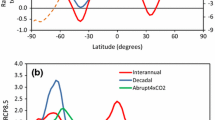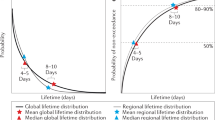Abstract
The water vapour feedback is the largest physical climate feedback. It also gives the second-largest contribution to the range of uncertainty in climate sensitivity in General Circulation Models (GCMs). Tracing these differences back to their physical causes in the hope of constraining climate sensitivity requires an appropriate quantification. Yet the Intergovernmental Panel on Climate Change judge that the conventional diagnosis of a “water vapour feedback” and a “lapse rate feedback” provides little insight into differences between GCMs’ climate sensitivities. We show that the conventionally diagnosed water vapour feedback is in fact formally useless for investigating differences between GCMs’ climate sensitivities—the anticorrelation between conventional “water vapour feedback” and “lapse rate feedback” makes the correlation between the “water vapour feedback” and their sum insignificant: i.e. statistically, knowing this “feedback” allows one to conclude nothing about the sum and thence about climate sensitivity. This follows primarily from how little relative humidity (RH) changes with climate change in GCMs. A more detailed physical analysis concludes that the overall mean decrease of RH on warming seen in GCMs is robustly physically based. This and other physical arguments then suggest that the stronger the positive “water vapour feedback”, the less sensitive climate can be expected to be. A diagnosis based on the “partly-Simpsonian” model of water vapour feedback avoids these problems. On the conventional view of the water vapour feedback, naive extrapolation of variations within present-day climate suggests that parts of our planet are close to locally reaching conditions that would allow a run-away water vapour greenhouse effect once they were extensive enough. Of course this has never occurred in geological history, and is not seen in Earth-like GCMs. Again, the “partly-Simpsonian” approach provides a simple qualitative explanation, by showing that the water vapour feedback can only cancel part of the basic Planck’s Law negative feedback.




Similar content being viewed by others
Notes
Conventions vary, but here “λ” means the net radiative response to global-mean temperature changes, in Wm−2/K, inversely proportional to climate sensitivity, and negative for a net negative feedback, i.e. a stable system.
References
Arrhenius S (1896) On the influence of carbonic acid in the air upon the temperature of the ground. Philos Mag 41:237–276
Bony S, Colman R, Kattsov VM, Allan RP, Bretherton CS, Dufresne JL, Hall A, Hallegate S, Holland MM, Ingram WJ, Randall DA, Soden BJ, Tselioudis G, Webb MJ (2006) How well do we understand and evaluate climate change feedback processes? J Clim 19:3445–3482. doi:10.1175/JCLI3819.1
Cess RD (1974) Radiative transfer due to atmospheric water vapor: global considerations of the Earth’s energy balance. J Quant Spectrosc Radiat Transfer 14:861–871
Cess RD (1975) Global climate change: an investigation of atmospheric feedback mechanisms. Tellus A 27:193–198
Colman R (2003) A comparison of climate feedbacks in general circulation models. Clim Dyn 20:865–873
Colman R (2003) Seasonal contributions to climate feedbacks. Clim Dyn 20:825–841
Colman R (2004) On the structure of water vapour feedbacks in climate models. Geophys Res Lett 31. doi:10.1029/2004GL020708
Colman RA, Power SB (2009) Atmospheric radiative feedbacks associated with transient climate change and climate variability. Clim Dyn. doi:10.1007/s00382-009-0541-8
Eyre JR (1981) Improvement of humidity analysis by direct use of Meteosat water vapour channel radiances. Preprints IAMAP symposium, Hamburg, 25–28 August 1981, ESA, pp 63–66
Hallberg R, Inamdar AK (1993) Observations of seasonal variations in atmospheric greenhouse trapping and its enhancement at high sea surface temperature. J Clim 6:920–931
Hansen JE, Lacis A, Rind D, Russell G, Stone P, Fung I, Ruedy M, Lerner J (1984) Climate sensitivity: analysis of feedback mechanisms. In: Hansen JE, Takahashi T (eds) Climate processes and climate sensitivity, American Geophysical Union, Washington, DC, pp 130–163
Hartmann DL, Larson K (2002) An important constraint on tropical cloud-climate feedback. Geophys Res Lett 29. doi:10.1029/2002GL015835
Held IM, Soden BJ (2000) Water vapor feedback and global warming. Annu Rev Energy Environ 25:441–475
Huybers P (2010) Compensation between model feedbacks and curtailment of climate sensitivity. J Clim 23:3009–3018. doi:10.1175/2010JCLI3380.1
Ingersoll AP (1969) The runaway greenhouse: a history of water on Venus. J Atmos Sci 26:1191–1198
Ingram W (2010) A very simple model for the water vapour feedback on climate change. Q J R Meteorol Soc 136:30–40. doi:10.1002/qj.546
Ingram WJ (2002) On the robustness of the water vapor feedback: GCM vertical resolution and formulation. J Clim 15:917–921
Ingram WJ (2012a) A new way of quantifying GCM water vapour feedback. Clim Dyn. doi:10.1007/s00382-012-1294-3
Ingram WJ (2012b) Water vapour feedback in a small multi-model ensemble. J Geophys Res 117:D12114. doi:10.1029/2011JD017221
Lu J, Vecchi GA, Reichler T (2007) Expansion of the Hadley cell under global warming. Geophys Res Lett 34:L06805. doi:10.1029/2006GL028443
Manabe S, Wetherald RT (1967) Thermal equilibrium of the atmosphere with a given distribution of relative humidity. J Atmos Sci 24:241–259
Minschwaner K, Dessler AE, Sawaengphokhai P (2006) Multimodel analysis of the water vapor feedback in the tropical upper troposphere. J Clim 19:5455–5464
Mitchell JFB, Ingram WJ (1992) Carbon dioxide and climate: mechanisms of changes in cloud. J Clim 5:5–21
Pennell C, Reichler T (2011) On the effective number of climate models. J Clim 24:2358–2367. doi:10.1175/2010JCLI3814.1
Randall DA, Wood RA, Bony S, Colman R, Fichefet T, Fyfe J, Kattsov V, Pitman A, Shukla J, Srinivasan J, Stouffer RJ, Sumi A, Taylor KE (2007) Climate models and their evaluation. Climate change 2007: the physical science basis. Contribution of working group I to the fourth assessment report of the intergovernmental panel on climate change, chap 8. Cambridge University Press, Cambridge, pp 589–662
Richter I, Xie S-P (2008) Muted precipitation increase in global warming simulations: a surface evaporation perspective. J Geophys Res 113. doi:10.1029/2008JD010561
Schmidt GA, Ruedy RA, Miller RL, Lacis AA (2010) Attribution of the present-day total greenhouse effect. J Geophys Res 115. doi:10.1029/2010JD014287
Sherwood S, Ingram W, Tsushima Y, Satoh M, Roberts M, Vidale PL, O’Gorman P (2010) Relative humidity changes in a warmer climate. J Geophys Res 115. doi:10.1029/2009JD012585
Simpson GC (1928) Some studies in terrestrial radiation. Mem R Meteorol Soc 2:69–95
Soden BJ, Bretherton FP (1993) Upper tropospheric relative humidity from the GOES 6.7 μm channel: method and climatology for July 1987. J Geophys Res 98:16669–16688
Soden BJ, Held IM (2006) An assessment of climate feedbacks in coupled ocean-atmosphere models. J Clim 19:3354–3360
Stocker TF, Clarke GKC, Le Treut H, Lindzen RS, Meleshko VP, Mugara RK, Palmer TN, Pierrehumbert RT, Sellers PJ, Trenberth KE, Willebrand J (2001) Physical climate processes and feedbacks. Climate change 2001: the scientific basis. Contribution of working group I to the third assessment report of the intergovernmental panel on climate change. In: Houghton JT, Ding Y, Griggs DJ, Noguer M, van der Linden P, Dai X, Maskell K, Johnson CI (eds) Cambridge University Press, Cambridge, pp 417–470
Tompkins AM, Emanuel KA (2000) The vertical resolution sensitivity of simulated equilibrium temperature and water-vapour profiles. Q J R Meteorol Soc 126:1219–1238
Yin JH (2005) A consistent poleward shift of the storm tracks in simulations of 21st century climate. Geophys Res Lett 32:L18701. doi:10.1029/2005GL023684
Zelinka MD, Hartmann DL (2011) The observed sensitivity of high clouds to mean surface temperature anomalies in the tropics. J Geophys Res. doi:10.1029/2011JD016459
Zelinka MD, Klein SA, Hartmann DL (2012) Computing and partitioning cloud feedbacks using cloud property histograms. Part II: attribution to changes in cloud amount, altitude, and optical depth. J Clim. doi:10.1175/JCLI-D-11-00249.1
Zhang MH, Cess RD, Hack JJ, Kiehl JT (1994) Diagnostic study of climate feedback processes in atmospheric GCMs. J Geophys Res 99:5525–5537
Acknowledgments
This work was funded by the joint DECC, DEFRA and MoD Integrated Climate Programme—DECC/Defra (GA01101), MoD (CBC/2B/0417_Annex C5), with writing up partly funded by NERC contract NE/D012287/1 and EU contract GOCE-505539. I am grateful to many Met Office colleagues, particularly Catherine Senior and Mark Ringer, for their support, and Keith Williams for the HadSM3 simulations. At AOPP it formed part of a doctoral project, where I am again grateful to many colleagues, particularly my supervisor Professor David Andrews, Myles Allen, Mark Munro, Stu Teasdale, Pardeep Pall and Simon Crooks. The multi-model analysis relies entirely on the valuable tabulations of Soden and Held (2006). Both content and presentation have benefitted greatly from comments from reviewers.
Author information
Authors and Affiliations
Corresponding author
Rights and permissions
About this article
Cite this article
Ingram, W. Some implications of a new approach to the water vapour feedback. Clim Dyn 40, 925–933 (2013). https://doi.org/10.1007/s00382-012-1456-3
Received:
Accepted:
Published:
Issue Date:
DOI: https://doi.org/10.1007/s00382-012-1456-3




